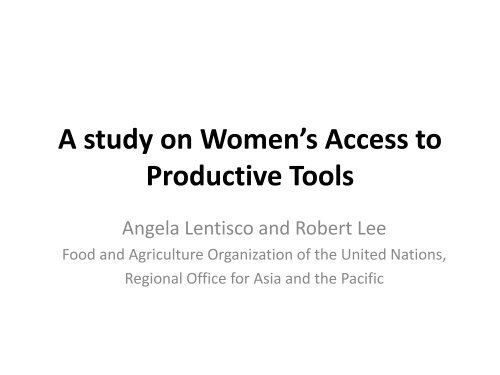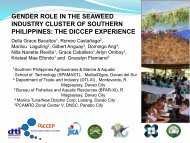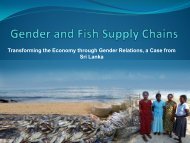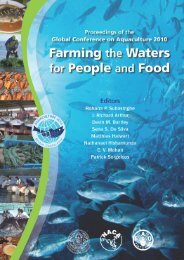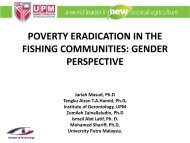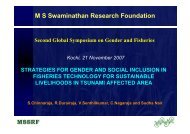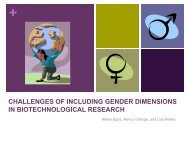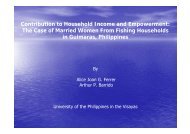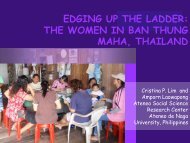Angela Lentisco - GENDER IN AQUACULTURE AND FISHERIES
Angela Lentisco - GENDER IN AQUACULTURE AND FISHERIES
Angela Lentisco - GENDER IN AQUACULTURE AND FISHERIES
You also want an ePaper? Increase the reach of your titles
YUMPU automatically turns print PDFs into web optimized ePapers that Google loves.
A study on Women’s Access toProductive Tools<strong>Angela</strong> <strong>Lentisco</strong> and Robert LeeFood and Agriculture Organization of the United Nations,Regional Office for Asia and the Pacific
Research questionWhat are the gains forwomen owning ormanaging productiveharvesting tools…- better economicbenefits?- better participation inresource management?- access rights to theresource?
HypothesisOwnership ofproductivetoolsAcceptance asprimaryresourceusersRights toaccessresourcesParticipate inFisheriesManagementImprovedIncomeImproved Profit, Foodand Nutrition Securityand Empowerment
Well documentedWomen = Processing(?)• In the SSF, women’s rolesare dominant in the postharvestsector.• They process fish products:drying, salting, smoking,making fish balls orfish/shrimp sauce, etc.• They either sell to generatea supplementary income,or use for householdconsumption (food &nutrition security).
How do women access fish?• Primary users: By fishingthemselves or owning theboat and gear• Secondary & tertiary users:They have access to thecatch from:– A male family member,usually husband.– Buying fish from themarket or landing site.– “Fish” for “sex”transaction (Bene &Merten, 2008).
Characteristics of Women Fishers• Short periods of time in river,lakes, near shore.• Accompanying theirhusbands/brothers and dosupporting roles.• They can also fish alone, butwill do it near their householdsin small boats.• They can collect shellfish(gleaning) close to shore, inthe intertidal area.• Daytime.
Characteristics of Women Fishers• They use homemade andlow-tech tools (e.g. bushknife, bucket, rod and line,etc. ), in contrast to moresophisticated gears that menhave better access to.• Some cases of women asowners of boats, engines andsmall enterprises – Ghana,Uganda, Chile, etc. (very littlework done on comparativeanalysis)
Constraints and perceptionshindering direct access to fisheriesresources and tools
Constraints and perceptions• Women’s fishing is categorized by being mainly forsubsistence, either for household consumption, or to be soldfor a small supplementary income.• Their activity is regarded in the informal sector, not beingaccounted for, and much less being managed (Norlund, 2012).• Lack of ownership of boats and gears hinders access rightsand participation in policy dialogue.• Lack of attention that fisheries agencies give to women’s rolesin fisheries management.• As a result, women do not receive any type of support orrecognition by government agencies.
Constraints…• the lack of representationin fisheries organizations,also means lack of:– participation in decisionmakingmechanisms,– access to credit– technology and gear– information and,– capacity building
• New technologiesbrought out withmodernization havedisplaced women.• As soon as a resourceobtained by womengain economicsignificance, men willdisplace women out offishing (e. g. CaseOctopus, Tanzania,Porter et al, 2008)Constraints…
Perceptions and beliefs (of others) on• It is not socially acceptable forwomen to go fishing atnighttime.• Some superstition and taboossuggest that women should notstay away from theirhouseholds during long periodsof time.• The perception also considersfishing as "too risky forwomen".• Government support programs,holding a perception thatfisheries is a male domain, donot target women asbeneficiaries.women going fishing
Women fishers own perceptions• They see actual fishing as oneof last resort and low socialvalue, mainly because of itssubsistence and informalnature.• If they do not perceive womenfishers as a professional group:– Do not demand support ofgovernment programs.– If the resource they gathergains higher relevance in themarket, they will likely bedisplaced.
However…• If certain fishing season requires extra labour, womenwill travel longer distances and for longer periodsaccompanying their husbands. (eg. Cambodia,Sopanha et al, 2008)• An increase in poverty levels can bring more womeninto fishing (e.g. Bangladesh, Sultana et al, 1998).• They can take on "male" type of fishing to supportthemselves and their families. (E.g. female fisherdivers in Korea, Haenyo, Gwi-Sook Gwon, 2005)
What do we know about the caseswhere there is direct access(and control)?
Social capital• In the case of the fish mammies in Ghana(Overa, R., 1993), the increase in productionand modernization also provided newopportunities for women thanks to theirkinship and marriage relationships.• In this case, it was women’s access to socialcapital and networks that secured theircontrol over technology and resources.
Community based organizations• Appropriate supporting actions to women’sorganizations and their recognition of their activities asa professional activity• Women’s own perceptions about their work canquickly change to a feeling of pride and belonging, to asense of collective self-worth which can improve theirown wellbeing as well as the management of theresources.– Women gleaners north of Spain (Marugan Pintos, 2004)– Women clams collectors of Tunisa (FAO Projectdocuments, 2012)– Women participation in colonia de pescadores (Yemayadossier, 2007)
Some questions on how to Promote GenderEquity and Empowerment of Women?(From COLLECTIVE ACTION <strong>AND</strong> ORGANISATIONS <strong>IN</strong> SMALL-SCALE <strong>FISHERIES</strong> - A BACKGROUNDNOTE – John Kurien)• The collaborative perspective: How can gender relations andwomen’s empowerment be factored into fisher organisationswhich deal with the activity of fishing that is an overwhelmingmale domain?• The independent perspective: Can gender relations andwomen’s empowerment issues be dealt with more fittingly infishworker organisations meant exclusively for women?
Approach to improve women’sparticipation• There are participatorymanagement arrangements thatcan improve women’s recognitionas fishworkers and guarantee theiraccess to productive resources.• But for this to happen, womenmust realize their own potential.• Adaptive governance (integrated,flexible and holistic approach)could be used to increasewomen’s participation in comanagement• Monitoring can be done throughoutcome mapping, with focus onbehavior change
Preliminary conclusions• Rights to access and control (decision-making) toresources and fisheries management–Empowerment is key– Do away with taboos– Greater perception of their role in fisheries – not justprocessing and marketing –away with the box– Greater ownership of productive tools such as boatsand gears– Greater recognition and action on promotingorganizational capacity– More strategic studies on socio economic roles infisheries production and management
Thank you for your attention!


